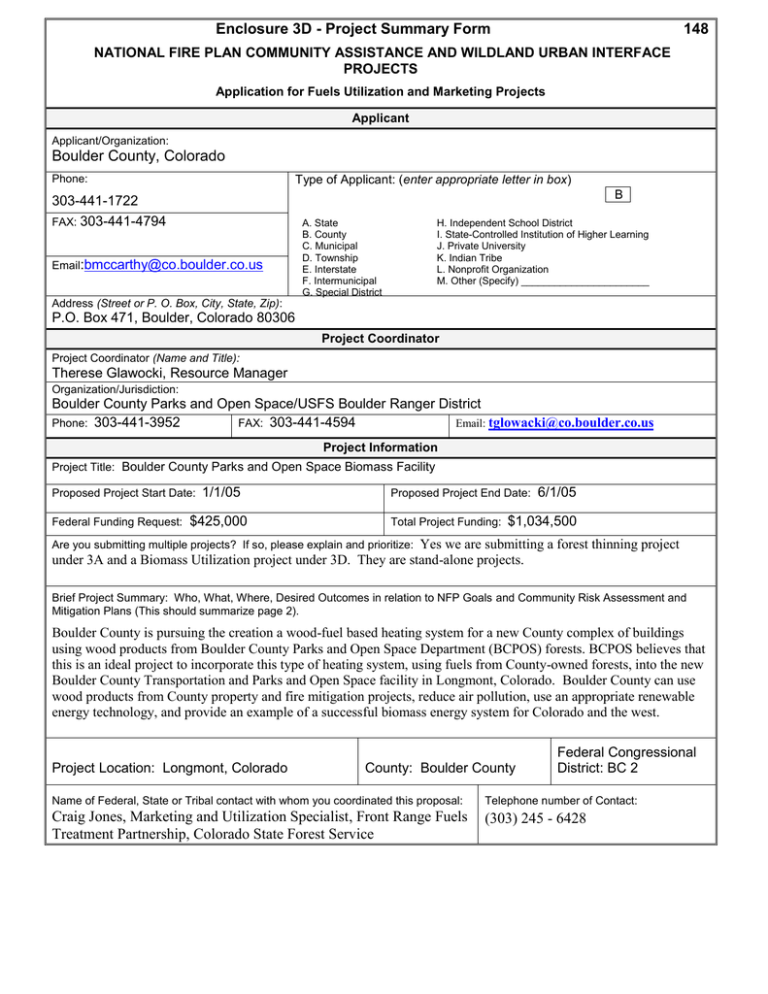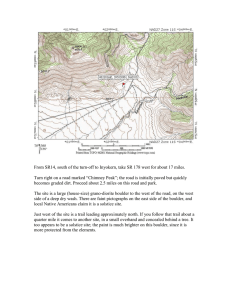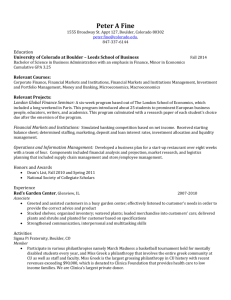Enclosure 3D - Project Summary Form ... Boulder County, Colorado
advertisement

Enclosure 3D - Project Summary Form 148 NATIONAL FIRE PLAN COMMUNITY ASSISTANCE AND WILDLAND URBAN INTERFACE PROJECTS Application for Fuels Utilization and Marketing Projects Applicant Applicant/Organization: Boulder County, Colorado Phone: Type of Applicant: (enter appropriate letter in box) B 303-441-1722 FAX: 303-441-4794 Email:bmccarthy@co.boulder.co.us A. State B. County C. Municipal D. Township E. Interstate F. Intermunicipal G. Special District H. Independent School District I. State-Controlled Institution of Higher Learning J. Private University K. Indian Tribe L. Nonprofit Organization M. Other (Specify) _______________________ Address (Street or P. O. Box, City, State, Zip): P.O. Box 471, Boulder, Colorado 80306 Project Coordinator Project Coordinator (Name and Title): Therese Glawocki, Resource Manager Organization/Jurisdiction: Boulder County Parks and Open Space/USFS Boulder Ranger District Phone: 303-441-3952 FAX: 303-441-4594 Email: tglowacki@co.boulder.co.us Project Information Project Title: Boulder County Parks and Open Space Biomass Facility Proposed Project Start Date: Federal Funding Request: 1/1/05 $425,000 Proposed Project End Date: Total Project Funding: 6/1/05 $1,034,500 Yes we are submitting a forest thinning project under 3A and a Biomass Utilization project under 3D. They are stand-alone projects. Are you submitting multiple projects? If so, please explain and prioritize: Brief Project Summary: Who, What, Where, Desired Outcomes in relation to NFP Goals and Community Risk Assessment and Mitigation Plans (This should summarize page 2). Boulder County is pursuing the creation a wood-fuel based heating system for a new County complex of buildings using wood products from Boulder County Parks and Open Space Department (BCPOS) forests. BCPOS believes that this is an ideal project to incorporate this type of heating system, using fuels from County-owned forests, into the new Boulder County Transportation and Parks and Open Space facility in Longmont, Colorado. Boulder County can use wood products from County property and fire mitigation projects, reduce air pollution, use an appropriate renewable energy technology, and provide an example of a successful biomass energy system for Colorado and the west. Project Location: Longmont, Colorado County: Boulder County Federal Congressional District: BC 2 Name of Federal, State or Tribal contact with whom you coordinated this proposal: Telephone number of Contact: Craig Jones, Marketing and Utilization Specialist, Front Range Fuels Treatment Partnership, Colorado State Forest Service (303) 245 - 6428 Enclosure 3D (Page 1 of 3) - Project Narrative Description Applications for funding must include a narrative response that describes the proposal. Please do not submit responses longer than one page, single space, 12-pitch font. Describe project including, but not limited to: Geographic scope of project Address these Is the project linked to a plan? items as Project time frames and partners applicable: Specify types of activities and equipment used Anticipated outcomes and measures of success How will the project results be reported? Special skills or expertise needed to complete the work For this project, explain the level of cooperation, coordination or strategic planning, through a “Local Coordination Group.” If you haven’t worked with a local coordination group, why not? The objective of this project is to create a wood-fuel based heating system for a new County complex of buildings using wood products from Boulder County Parks and Open Space Department (BCPOS) forests. The forest management aspect of the project involves thinning efforts on County property that provide fire mitigation in the wildland urban interface. Many of our properties are bordered by private property and subdivisions at significant risk of catastrophic fire. Secondly, the biomass utilization will provide a commercial use for the small diameter wood products (chips) that result from fire mitigation thinning. It will also reduce air pollution from current slash pile burning. Thirdly, this promotes the use of a renewable energy technology and could promote small commercial operations to develop as a result. Finally, if successfully developed, this new facility will be an excellent demonstration for wood-fuel based heating for Boulder County, the state of Colorado, and foresters, farmers and ranchers in the west. Response: Boulder County currently thins 100 to 150 acres/year of forestland for forest stand improvement and fire mitigation. BCPOS staff estimates that Boulder County forest thinning projects produce approximately10 tons per acre thinned of green chips per acre, thus the County has to dispose of 1,000 to 1,500 tons of green wood chips per year. The proposed wood-chip system would require approximately 648 tons of chips annually, which will supply 6717 Mbtu. This equates to about 65 acres of forest thinning per year, therefore all the wood needed for the biomass boiler can come from BCPOS thinning operations. BCPOS staff estimates that based on existing thinning operations and remaining acres to be thinned, the County will have over 100 years of fuel supply from County owned property. In evaluating the need and potential usage of a wood-fuel heating system, Boulder County contracted with McNeil Technologies, Inc. to conduct a feasibility study of the project. This evaluation included determining the size of the heating system based on the new facility, estimating the amount of wood required to operate such a system, analyzing BCPOS’ ability to meet these wood-fuel needs based on average annual forest thinning operations, calculating air quality impacts of using the wood for fuel versus burning wood for disposal, estimating capital costs, and analyzing the economics of the project. Boulder County’s review of the feasibility study resulted in a decision by the County Commissioners to go forward with implementing the wood-fuel heating system backed by a natural gas system if grant funding could be found to offset the additional capital costs of the project. If no outside funding is found, BCPOS risks the possibility that the system may not be implemented. The remaining project work plan and schedule will be: 1) determining funding possibilities; 2) final sizing of buildings and site plan – timeframe of six months; 3) construction of facilities (site work, infrastructure, construction of shell and interior work)- timeframe of 12 months; 4) departments move-in in phases beginning mid to late 2005 and system begins operating. Anticipated outcomes include measuring energy efficiency, which should save Boulder County approximately $34,000 to $55,000 per year. Over the 30-year expected life of the wood-fired system as built, with BCPOS supplying the wood fuel, the operational costs are lower than natural gas costs. The construction project will be jointly managed by the Boulder County Architect’s and Transportation departments and their contractors. All contractors will be hired subject to insurance and indemnification provisions required by Boulder County, including any necessary bonding requirements. The BioEnergy Resource Center from Vermont is one of the contractors already hired as a technical consultant for the biomass heating system. Boulder County is confident that any potential problems can be mitigated and the project will be evaluated and monitored in a competent manner. After construction is complete, Boulder County Facilities staff will provide overall management of the buildings and heating system. Enclosure 3D (Page 2 of 3) - Project Evaluation Criteria Applications for funding must include narrative responses that address the following four criteria. Within each criterion, subcriteria are listed in descending order of importance. Limit your responses to the areas provided. 1. Increasing Economic Utilization of Woody Material Removed in Fuels Management and Forest Restoration Activities (50 Points) A. Will biomass or forest fuels be utilized? If so, in what manner and how much? B. Will the project improve the local economy in terms of jobs and sustainable economic activity? C. How many jobs are expected to be created or retained, and for how long? D. Are any private businesses involved in this project? If so, what are their roles? E. Can this project be offered to serve as a model to other communities or businesses? If so, why and how will the model be conveyed or made available? F. If the project involves new product development, what evidence is there for appropriate markets and end-users? G. How will the project be sustained or carried forward beyond the project timelines? Will it depend on public funding sources? Response: A. Forest fuels from BCPOS property will be utilized. Boulder County currently thins 100 to 150 acres/year of forestland for forest stand improvement and fire mitigation. BCPOS staff estimates that Boulder County forest thinning projects produce approximately10 tons per acre thinned of green chips per acre, thus the County has to dispose of 1,000 to 1,500 tons of green wood chips per year. This proposed wood-chip system would require approximately 648 tons of chips annually, which will supply 6717 Mbtu. This equates to about 65 acres of forest thinning per year, therefore all the wood needed for the biomass boiler can come from BCPOS thinning operations. BCPOS staff estimates that based on existing thinning operations and remaining acres to be thinned, the County will have over 100 years of fuel supply from County owned property. B. This project will improve the local economy by providing a commercial use for the small diameter wood products (chips) that result from fire mitigation thinning. The project will also reduce air pollution from current slash pile burning, and the project promotes the use of a renewable energy technology and could promote small commercial operations to develop as a result. C. The County will hire numerous outside contractors to complete this project, resulting in job creation, for approximately 12 to 18 months. Privates contractors will conduct forest thinning and haul the fuels. D. Boulder County contracted with McNeil Technologies, Inc. (McNeil) to conduct a feasibility study of the project, and the BioEnergy Resource Center from Vermont is one of the contractors already hired as a technical consultant for the biomass heating system. Boulder County has also hired an outside general contractor, Keith Benson, to oversee the project. E. This project will be an excellent model for wood-fuel based heating for other businesses and agencies in Boulder County, the state of Colorado, and the west. If successful funding is found and the facility is constructed, the project will be open for the public to review. Boulder County would be enthusiastic to share any information to further this new technology. F. There are many markets where this technology would be appropriate. For example, Forest Service land in the Arapaho National Forest that surrounds Boulder County land is in an overgrown state. Thinning operations on federal land may provide a market for new commercial industries by generating wood chips to sell to those entities that have biomass facilities, thereby creating the potential for additional job growth in Colorado. G. After construction is complete, Boulder County Facilities staff will provide overall management of the buildings and heating system. Boulder County Facilities has a staff of 18 people who provide management services of over 30 Boulder County facility buildings. In addition, Boulder County Facilities has trained heating/cooling mechanical employees that will provide the day-to-day operational management of the proposed wood-fired boiler system. The on going support of operational and maintenance costs will be through Boulder County’s annual budget. Enclosure 3D (Page 3 of 3) - Project Evaluation Criteria A. B. C. D. E. 2. Expanding community participation and collaboration. (30 points ) Identify the partners and community members involved in planning and implementing the project. Describe the extent of local support for this project. How much cost sharing is there for the project? Who are these partners and what are the arrangements? What are the direct community benefits that will result from this project? How will you use multi-party monitoring to improve this and future projects? Response: A. Boulder County Parks and Open Space currently works with the USFS and the Colorado State Forest Service in its thinning operations, as many of the 20,000 acres of forestland is surrounded by USFS land. The development process is public, so community members’ input will be reviewed. In addition, the City of Longmont will be instrumental in the planning and implementation of this project. B. The mountain communities are in continuous support of Boulder County’s fire prevention services including forest-thinning projects, especially in light of the numerous fires in the state of Colorado over the past three years. The County encourages local support of all projects and anticipates incorporating public review into this project. Due to the many positive impacts this project has, the County anticipates that public support will be significant. C. Boulder County will provide over a 55% match for this project. D. Fire mitigation in the wildland urban interface; opportunity for job creation for new technology; improvement in mountain air quality. E. Boulder County will monitor the project by assessing the system on a daily, weekly and monthly basis, estimating fuel usage and flow; Boulder County Facilities will monitor the project after final completion. 3. Taking Advantage of Existing Networks, previously funded projects and knowledge. (20 Points) A. Describe how the proposed project takes advantage of relevant, existing networks and previously funded projects. B. Describe who and what (reports, studies, internet sites, etc.) were consulted to ensure the best information available was used in designing this project proposal. Response: A .Boulder County will be using a new technology for heating of a proposed facility. There is a network of existing fuels for this project, and the County has the system for creation, transportation and maintenance of these fuels in place. The County studied existing facilities in the Vermont area (and in Nederland, Colorado) to ensure that this type of project would work well in the Boulder County area. In addition, the County works closely with the USFS and the Colorado State Forest Service to determine appropriate programs for forest health. Boulder County will share all information with these partners for potential educational opportunities for those entities who are willing to entertain new technologies. B. Boulder County contracted with McNeil Technologies, Inc. (McNeil) to conduct a feasibility study of the project, and the BioEnergy Resource Center from Vermont is one of the contractors already hired as a technical consultant for the biomass heating system. Boulder County has also hired an outside general contractor, Keith Benson, to oversee the project. Enclosure 3D - Project Work Form Tasks Time Frame Responsible Party Determining funding possibilities. 6 months Boulder County Parks and Open Space Final sizing of buildings and site plan. 6 months Boulder County Parks and Open Space; Boulder County Facilities Construction of facilities (site work, infrastructure, construction of shell and interior work). 12 months Outside contractors; Boulder County Parks and Open Space; Boulder County Facilities Boulder County Parks and Open Space Department and Boulder County Transportation move-in; in phases beginning mid to late 2005 and system begins operating. 6 months Boulder County Parks and Open Space; Boulder County Facilities System Review and monitoring. Daily, weekly, monthly and annual Boulder County Parks and Open analysis of operations Space; Boulder County Facilities Enclosure 4D - Project Budget Cost Category Description Federal Agency Applicant Partner 1 Partner 2 Total Personnel *Estimated labor costs 100,000 100,000 409,500 834,500 Subtotal Fringe Benefits Subtotal Travel Subtotal Equipment *Capital cost of materials & equipment fo Subtotal 425,000 Supplies Subtotal Contractual Subtotal Other Subtotal Total Costs 425,000 509,500 1,034,500 Project (Program) Income1 1 Program income is the gross revenue generated by a grant or cooperative agreement supported activity during the life of the grant. Program income can be made by recipients from fees charged for conference or workshop attendance, from rental fees earned from renting out real property or equipment acquired with grant or cooperative agreement funds, or from the sale of commodities or items developed under the grant or cooperative agreement. The use of Program Income during the project period may require prior approval by the granting agency.







